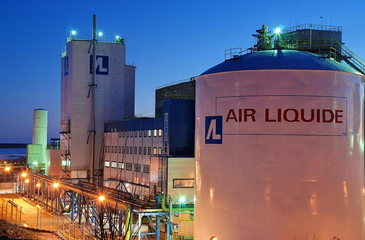Air Liquide presents an innovative ozone input technology with its ozone-rich water technology. The new process optimizes the oxidation process, uses the oxygen off-gas produced and creates new, previously unused degrees of freedom in the design of the ozone reactors.
Ozone, a molecule made up of three oxygen atoms (O3), is the strongest oxidizing agent that can be produced on an industrial scale. It completely eliminates a large number of problematic substances or oxidizes them to such an extent that they are subsequently biodegradable - and reacts to form comparatively unproblematic oxidation products plus oxygen. The new ozone-rich water technology from Air Liquide, one of the leading companies in gases for industry, medicine and environmental protection, is designed to optimize the oxidation process, using the oxygen off-gas produced and creating new, previously unused degrees of freedom in the design of the ozone reactors.
Areas of application for ozone high pressure water injection technology
In many areas of water treatment, for example in drinking water treatment, waste water treatment and process water treatment, ozone is very often used in low concentrations or dosages. Air Liquide's new ozone-rich water system is now said to be predestined for the loss-free addition of low to medium ozone doses to large water volume flows with high efficiency and cost-effectiveness, while at the same time offering a high degree of freedom in reactor technology. In addition, the space required for the additional purification stage is minimized, the "ozone oxidation" is optimized and the offgas (valuable oxygen) is additionally utilized. In contrast to conventional structures based on higher water depths, the design of the ozone reactors can be chosen completely freely. As the ozone is already completely dissolved in the ozone-rich water technology, the task of the ozone reactors is limited purely to the ozone reaction and its progression over time.
Demand-oriented ozone dosing
At present, ozone is still conventionally fed into the ozone reactors via diffusers or pump-injector systems and dissolved there. Dosing is either proportional to quantity or controlled by measurement technology in the inlet and outlet of the reactors. This can lead to considerable overdosing in the reactor, either temporarily or locally, which does not meet demand. Overdosing means increased oxidation of the other substances present in the water matrix, for example from bromide to bromate. Due to the separation of the process steps and the intelligent measurement of the dissolved ozone concentration, overdosing is largely ruled out. In addition to reducing the ozone requirement, further unwanted reactions of the background wastewater mix are also minimized.
Pilot plants for feasibility studies and on-site tests
The use of ozone always presents both planners and operators with individual challenges. Although ozone oxidation has been common practice for many decades, each application must be considered on a case-by-case basis. Depending on the substances or groups of substances to be oxidized, the required ozone demand and the system design for each project must be determined in advance. The plant to be planned on the basis of this data usually represents a very high investment. Pilot tests on site with mobile ozone pilot plants simplify the decision-making process and enable a targeted design of the required plant technology based on the design parameters actually determined on site. Air Liquide enables pilot trials for feasibility studies and tests both with the new ozone-rich water technology and with conventional ozone applications - either in the technical center or directly on site.
www.hannovermesse.de


 Deutsch (Germany)
Deutsch (Germany)  Polski (PL)
Polski (PL) 

















































